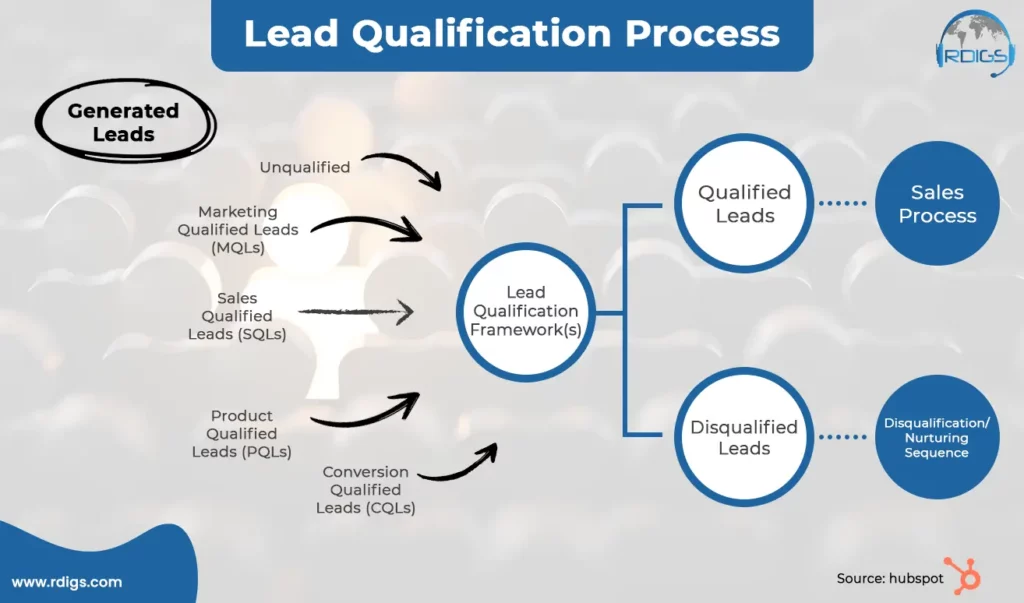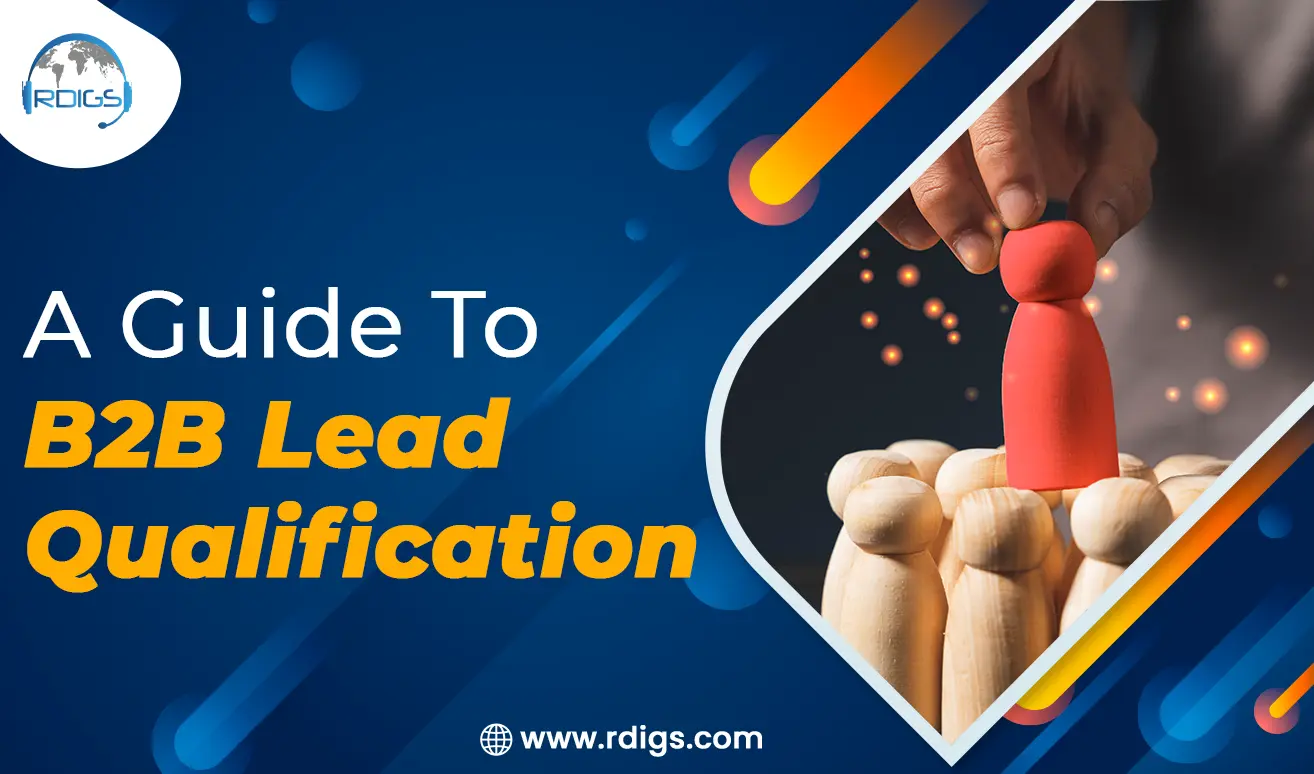Today, businesses may attract leads from various sources. However, not all leads are equal. Some may merely be curious visitors, others might be casually browsing, while a select few hold the potential to become valuable customers. The tricky part is figuring out which leads are worth pursuing and how to effectively nurture them so that they turn into customers who are loyal to your brand. According to research, only 25% of leads are legitimate and have the potential to become paying customers. Statistics also reveal that 79% of leads will never advance towards sales, which clearly indicates that you might fail.
It is where B2B lead qualification steps in—a systematic and teamwide approach to determining the worthiness of a lead. By implementing a comprehensive lead qualification process, you can ensure that you deliver the correct information to the right people at the right time, maximizing your chances of converting leads into long-term business relationships. Try to understand it this way like a gentle whisper in a crowded room, it ensures that valuable resources are channelled towards those destined to be more than mere acquaintances, nurturing relationships that transcend the ordinary.
If you want to learn and get a hold of B2B lead qualification, then make sure to stick around until the end of this article.
What is a B2B Lead Qualification?
B2B lead qualification is the process of evaluating and determining the quality and suitability of potential B2B leads. It involves assessing and filtering leads to identify those that are most likely to become valuable customers or clients for a business. The purpose of the lead qualification is to concentrate marketing and sales efforts on prospective clients who are more likely to convert into paying customers, thus maximizing the use of available resources and enhancing the overall effectiveness of the sales process.
Typically, the lead qualification process involves the following:
- Collecting information about prospects and evaluating them against specific criteria to determine their level of interest.
- Purchasing propensity.
- Compatibility with the company’s ideal consumer profile.
This information can be obtained through various channels, including online forms, lead generation campaigns, phone calls, and trade show and event interactions.
For instance, A digital marketing agency narrows down 5,000 leads to 15 highly qualified prospects. One of them, a struggling e-commerce business needing SEO services, becomes their focus. The agency converts the lead into a client through dedicated efforts, resulting in increased organic search visibility and conversions. Lead qualification drives successful outcomes by targeting high-potential prospects.
The above examples show that with lead qualification, success is straightforward. Contacting all 5,000 prospects would not have generated the same level of success and would have required more time and resources.
Why is B2B Lead Qualification Important?
B2B Lead qualification is essential in the world of B2B sales. With it, your company will stay energized and save time and resources. Why invest in protracted sales conversations with prospects who are incompatible with your product or uninterested? The qualification of B2B leads provides clarity, directing your efforts toward promising prospects and ensuring valuable outcomes. Businesses can maximize their sales and marketing resources by evaluating and prioritizing leads thoroughly. Because time and resources are limited, it is vital to prioritize the most promising leads.
Lead qualification enables businesses to evaluate factors such as compatibility, authority, need, and engagement, directing resources towards prospects who closely match their ideal consumer profile. This strategic allocation of resources strategically improves productivity, reduces wasteful effort, and ultimately results in a greater return on investment (ROI). Lead qualification enhances sales efficiency and effectiveness significantly.
The process seeks to identify prospects who are interested in making a purchase and are prepared to do so. By evaluating factors such as timing and budget, businesses can focus on prospects who are in the appropriate phase of the buying journey and have the financial means to convert. This targeted approach streamlines the sales process by enabling sales teams to concentrate on qualified prospects, which increases the likelihood of closing transactions and shortens the overall sales cycle. The result is increased conversion rates and increased revenue.
B2B Lead Qualification Glossary
Now that the importance of B2B lead qualification has been established, it is time to examine the B2B Lead Qualification Glossary, clarifying the technical jargon and acronyms involved. Rest assured; it’s not as difficult as it appears! Let’s embark on this illuminating voyage to thoroughly comprehend the three categorizations and classifications of your B2B leads.
Certainly! Let’s define three common categories in B2B lead qualification: MQL (Marketing Qualified Lead), SQL (Sales Qualified Lead), and PQL (Product Qualified Lead). Understanding these distinctions is crucial for effective lead management and conversion.
MQL (Marketing Qualified Lead):
An MQL is a lead that has demonstrated a certain level of interest and engagement with your marketing efforts, indicating potential as a sales opportunity. These leads are typically generated through marketing campaigns, website forms, or content downloads. MQLs may have shown interest by subscribing to a newsletter, downloading an e-book, or attending a webinar. However, they may still need to be fully ready for direct sales engagement. Only 44% of MQLs pass through sales as a potential good fit.
Example: A software company offers a free e-book on effective project management. When a lead downloads the e-book from their website, they become an MQL, showing an initial interest in the company’s expertise.
SQL (Sales Qualified Lead):
An SQL is a lead that has been thoroughly assessed and determined to be a potential customer by the sales team. SQLs have passed certain criteria, such as specific needs, budget availability, and decision-making authority within their organization. They are considered more likely to convert into paying customers and are ready for direct sales engagement.
Example: An SQL could be a lead that has requested a personalized product demo, provided detailed information about their company’s requirements, and confirmed their budget and purchasing timeline.
PQL (Product Qualified Lead):
A PQL is a lead that has demonstrated high engagement with your product or service. This type of lead has already experienced the value and benefits of your offering, often through a free trial or freemium version. Their usage and interaction with your product indicate strong potential as a paying customer.
Example: A SaaS company provides a free trial of their project management software. A lead who signs up for the trial, actively uses the features, and achieves significant project milestones becomes a PQL, displaying a solid intent to purchase.
Lead Qualification Process: Step by Step
The lead qualification process equips companies to successfully navigate the vast field of potential customers and serves as their compass on the road to sales success. Identifying the most promising prospects and optimizing resource allocation is essential because each lead presents different opportunities and challenges. Businesses can efficiently evaluate and prioritize leads by establishing a step-by-step lead qualification process, ensuring that valuable time and resources are concentrated on those with the highest potential for conversion. Each stage of the process, from the first contact to the last qualification, moves businesses one step closer to creating lasting customer relationships and achieving their sales targets.


The lead qualification process involves several key steps to effectively assess and prioritize potential B2B leads. Here is a step-by-step guide to the lead qualification process:
Define Lead Qualification Criteria:
To begin, depending on the characteristics of your ideal client, formulate specific criteria to determine what exactly qualifies as a qualified lead. Think about the sector your business operates in, the size of your firm, the region you’re in, your budget, and the unique problems your product or service solves.
Lead Generation:
Leads may be generated through various means, including forms on your website, content downloads, social media campaigns, trade events, and referrals. Collect all of the pertinent information there is to know about the leads, such as their contact information and any other data that qualifies them.
Initial Lead Scoring:
Conduct an initial lead scoring process utilizing the information supplied to find leads that fulfil the fundamental qualifying requirements. It is necessary to assign ratings or labels to leads to prioritize them for further examination.
Qualification Research:
Carry out some research in order to gain further information on the leads. This may entail looking at their website, their presence on social media, recent news in the business, or conducting early interactions through phone or email to evaluate their compatibility, needs, and degree of participation.
Lead Engagement:
Engage with the leads using individualized contact methods such as emails, phone calls, or other focused marketing initiatives. This allows you to evaluate their response and degree of interest and gain further information about their precise requirements.
Qualification Questions:
Ask the right qualifying questions to determine the lead’s budget, timeframe, decision-making process, and pain issues. This gives you insight into whether or not your product or service is a good fit for their needs and whether or not they are ready to make a purchase.
Lead Scoring and Prioritization:
Assign scores to leads depending on the replies they provide and the level of involvement they show. It is important to give more priority to leads with higher scores since higher scores suggest a better match and a higher possibility of conversion. Because of this, your sales staff can concentrate their efforts on prospects with the most potential.
Validation and Verification:
Validate the information that the leads are supplying to ensure that it is accurate and dependable. Verify important data such as the lead’s company size, decision-making power, budget availability, and any other vital criteria that may have an influence on the lead’s qualifying.
Handoff to Sales:
Engage your sales staff to take over and continue the sales process once a lead has proved that they fulfil the predefined qualifying criteria and are highly interested in what you are selling. Give them detailed lead profiles, information on how to qualify them, and relevant context to use when discussing with prospective customers.
Ongoing Lead Nurturing:
Implementing lead nurturing tactics allows you to maintain a connection with leads who still need to satisfy the qualifying requirements or who are still waiting to make a purchase. This will enable you to present them with helpful material or resources. Maintain constant vigilance over their level of participation and periodically review the qualifications they now have as they make progress.
Editor’s Note
The process of B2B lead qualification is essential for businesses aiming to achieve sales success. It ensures that valuable time and resources are focused on the most promising leads and maximizes the chances of converting them into long-term customers. By defining clear qualification criteria, generating leads through various channels, and engaging in research and personalized communication, businesses can evaluate leads based on their fit, need, and level of engagement. Lead scoring and prioritization help identify the most qualified leads, while validation and verification ensure the accuracy of lead information.
The future of B2B lead qualification is marked by innovation, automation, and personalization. By staying at the forefront of industry advancements and embracing emerging technologies, businesses can position themselves for success in a dynamic and competitive landscape. The process of B2B lead qualification is essential for businesses aiming to achieve sales success. It ensures that valuable time and resources are focused on the most promising leads and maximizes the chances of converting them into long-term customers.
New channels and platforms will emerge, offering businesses novel ways to generate and qualify leads. Social media, influencer marketing, and personalized content experiences will play an increasingly significant role in lead qualification, allowing businesses to engage prospects on their preferred platforms and establish authentic connections. We may see the integration of AI-powered chatbots and virtual assistants, enabling instant lead qualification and engagement, thereby accelerating the sales cycle. Automation will further optimize the lead qualification process, freeing up valuable human resources to focus on strategic initiatives and nurturing relationships.
If You Enjoyed Exploring A Guide to B2B Lead Qualification, You’ll Love Our Previous Blog on Data Silos: The Hidden Barrier to Effective B2B Decision-Making check it out for more insightful content and expand your knowledge in the world of B2B strategies and customer experiences. Dive in now and discover new perspectives that will take your business to the next level.

